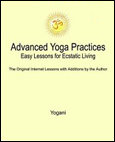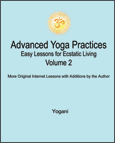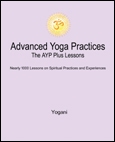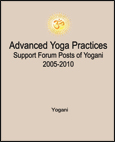|
Public Home | Plus Home | Main Lessons | Tantra Lessons | Public Forum | Plus Forum | Downloads | Books Topic Paths | Search | Training-Retreats | Testimonials | Survey | Interviews | MultiMedia | Contact | Donate |
|
Advanced Yoga Practices Note: For the Original Internet Lessons with additions, see the AYP Easy Lessons Books. For the Expanded and Interactive Internet Lessons, AYP Online Books, Audiobooks and more, see AYP Plus. Lesson 351 - Adding Self-Inquiry to Core Samyama Practice (Audio)
AYP Plus Additions: From: Yogani New Visitors: It is recommended you read from the beginning of the archive, as previous lessons are prerequisite to this one. The first lesson is, "Why This Discussion?"
Each of us will come to self-inquiry in our own way. Our chosen approach may mix and match elements from any or all of these kinds of practice. If we are cultivating abiding inner silence in deep meditation, we will begin to find traction in our self-inquiry sooner rather than later. We call this "relational," because inquiries released in stillness are going to move stillness and bring about true Self-realization. Before that, our inquiries will be in the mind and will have limited effect on our spiritual progress. In fact, "non-relational" self-inquiry (in mind rather than in stillness) can build obstructions to our progress in the mind and emotions. See Lesson 325. The same is true of samyama. This is why we have said that at least a little abiding inner silence is a prerequisite for samyama practice. It is not as critical as in the case of self-inquiry, because samyama is an aspect of our twice-daily sitting practices, and we can afford some inefficiency in structured practice as we gradually develop the habit of releasing our samyama sutras in stillness. Then this habit of releasing in stillness will begin to manifest in daily activity in positive ways as abiding inner silence, and its natural movements gradually increasing in our life. On the other hand, self-inquiry is an activity that we may be inclined to undertake outside sitting practices during normal activity. If inner silence and our ability to release intentions in stillness are limited, self-inquiry can place a drag on the quality of our life, even going so far as to negate our life prior to the rise of Self-realization. We'd prefer to find a way to cultivate self-inquiry as a natural result of sitting practices, so that forcing on the level of the mind and its associated difficulties in daily life can be minimized. We have already discussed from many angles in previous lessons how the habit of samyama naturally creeps from structured sitting practice into our daily activity, with the many practical benefits that come with that, including the natural enlivening of whatever kind of self-inquiry we may be drawn to. But so far, we have not introduced means to bring self-inquiry back into our structured sitting practices in a way that can efficiently and naturally advance our ability to inquire for Self-realization in daily life. In this lesson we are going to address this directly by suggesting the optional addition of a self-inquiry sutra to our core samyama practice. For a review of core samyama practice, see Lesson 150. The new sutra is: "I-thought Who am I?" Our complete set of sutras in core samyama practice would then become: Love Radiance Unity Health Strength Abundance Wisdom Inner Sensuality Akasha Lightness of Air I-thought Who am I? For those who choose to add the self-inquiry sutra, the instructions for practice in Lesson 150 remain unchanged. We would just be adding one new sutra, expanding the list from nine to ten. Also, for those who take this step, it is suggested to make the new self-inquiry sutra the default for additional repetitions at the end of the session. So, if we are doing two repetitions of 15 seconds release in stillness for each sutra, taking about five minutes to get through the list, when we get to the end of the list, we have the option to do about five minutes of repetitions with the self-inquiry sutra. If we are only doing one repetition with our sutras, we can do a couple of minutes with the self-inquiry sutra at the end. If we are doing four repetitions with our sutras, we may consider doing up to 10 minutes of self-inquiry sutra repetition at the end. Like that. It is best to develop a steady habit in our core samyama practice, not switching things around too often. The habit of attention in relation to the refinement of neurobiological functioning will go gradually deeper over time with the consistency of our daily practice routine, and the results will be more steady in daily activity, which is where we'd like to see them. Speaking of results, what might we see emerging in our life from the addition of this self-inquiry sutra? For that, let's look at the sutra itself. The sutra has two parts. The first part is "I-thought." This is the "I" that we are so familiar with in everyday life I am thinking this, I feel that, I am doing this, etc. It is the "I" we are repeating to ourselves and others incessantly from the moment we wake up in the morning until the moment we drift off to sleep at night. We may even be engaged in our I-thought during dreaming while we are asleep. We can't seem to get away from it, except in deep dreamless sleep. We use the phrase "I-thought" instead of "I" to bring clarity to the fact that the "I" is a thought, and not the subject or true observer in anything we do. Yet, it is the common denominator in everything we think, feel and do. A little inquiry reveals this to be so. Who is it that is thinking, feeling, and doing this right now? It is I. It is the I-thought. It always comes down to that. So this is where we start in the sutra. In finding the source of the I-thought, we find the source of all. The second part of the sutra is "Who am I?" which needs little explanation, except to say we are not responsible to find any answer to this question in our mind. The inquiry is part of a sutra. We pick up the faint feeling of "I-thought Who am I?" let go in stillness for 15 seconds, and repeat. With this sutra, we are taking the I-thought, and inquiring its source in stillness. We are beginning to penetrate the "I" that is behind everything we think, feel and do all day long, dissolving the illusion of our false sense of self. In structured samyama practice, this process carries on irrespective of anything we may be thinking or feeling, just as will be the case with any other sutra. We favor the procedure over any experience that may come up. We do not analyze the sutras or anything that may result from their use during practice. Later on, after our practice, we can analyze all we'd like. In fact, we may find that our attempts at self-inquiry in normal daily activity will be taking on a deeper quality of knowing after using this additional sutra for a few weeks or months. By that we mean, the answer to the inquiry gradually comes into our life. What is the answer? Is it an idea? A pronouncement or an affirmation? An "Aha!" in the mind? Not really. It is the condition of our own Self emerging in everyday activity. The answer is not in the mind at all. It cannot be known there. It is beyond the I-thought itself. The answer is in the condition of the Self. We become That, and That is unknowable by the mind or the I-thought. The process is similar to the rise of inner silence (the witness) we are familiar with from our daily deep meditation practice, with one significant difference. With effective self-inquiry, the I-sense, the I-thought, recedes into the witness, and along with it, the perception of a dual condition of witness and witnessed. It is going beyond the witness stage. The subject-object relationship becomes transparent, going from two to One. The mind and the I-thought are left behind, though they appear to continue functioning more or less normally. This is the paradox of enlightenment. Everything changes for us and our surroundings, though nothing may appear to be changing much at all. This is what knowing the unknown is like. While we may be able to intellectually understand that our sense of "I" is only a thought, the root thought of all other thoughts, this practice will take it much further. Self-inquiry in structured samyama practice dissolves the I-thought deep within us, at its source, beyond the mind and the intellect, which is where all self-inquiry must go. When we get up from practice and go out into the world, we begin to see things differently. The I-thought and all of its illusions will be fading away, being replaced with peace and divine love, which have always been there just beneath the confusion of ego-driven life. This addition to samyama practice will not conflict with any other kind of self-inquiry we may doing during the day. It is likely to enhance it. We may find our perspective shifting in life, and in how we regard the world, with a greater sense of freedom coming up. Our self-inquiry during the day will shift to deeper insight. It is always our choice, of course. We will be choosing from a deeper place. Ultimately, we will be choosing from no place at all. Yet, life goes on. We will know it from the perspective of outpouring divine love and stillness in action, and not even that, for these are experiences in time and space also. The Self is beyond all that, beyond any divine process the mind can imagine or perceive. It should be mentioned that this is a powerful addition to samyama practice, and like any other practice, it can be overdone. So it will be good to start out slow, being prudent in self-pacing our practice according to our experiences in daily activity, as always. If we find ourselves getting a bit frayed and frazzled during the day, it will be good to back off a bit until things smooth out. Much better to be moderate in practice, relax and enjoy the ride, than to get into uncomfortable delays from overdoing and having to spend valuable time recovering. In addition to the normal energy issues that can come up from overdoing practices, there can be some doubts occurring as duality dissolves into non-duality. We may question whether we are really ready to give up our ego, and live the full consequences of that. It is freedom of the highest order, but it cannot be lived by maintaining the status quo of I, me and mine. A shift occurs that relies on our surrender. It does not mean we will change our lifestyle dramatically. It only means that our point of view on life will shift. It will take some courage to let the old self-identified perceptual habits go. This samyama addition will lead directly to that transformation, and some trepidation along the way will be normal. We will be wise to self-pace for that also. We'd like to have good progress with comfort and safety. If given the choice, we will take the smooth ride over the bumpy one. We always have a choice. So practice wisely, and enjoy! The guru is in you. See this complete instructional lesson and all the expanded and interactive AYP Plus lessons at:
Samyama Related Lessons Topic Path Discuss this Lesson in the AYP Plus Support Forum Note: For detailed instructions on samyama practice, covering multiple applications and self-directed research, see the AYP Samyama book and the AYP Liberation book, and AYP Plus. |
|
|
|
Join the Mail List:
AYP Retreats
eBooks - PDF, EPUB
FREE eBooks with
SAVE with Bundled
|

























